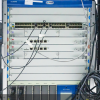Find the best fit for your network needs

share:
 800GBASE-2xSR4 OSFP PAM4 850nm 50m MMF Module
800GBASE-2xSR4 OSFP PAM4 850nm 50m MMF ModuleLearn More
Popular
- 1Optical Transceivers and Artificial Intelligence: Jointly Creating an Intelligent Era
- 2The Differences Between Industry & Commerical Transceiver
- 3AI Drives Demand for Optical Transceivers
- 4The Key Role of High-quality Optical Transceivers in AI Networks
- 5Common Problems While Using Optical Transceivers in AI Clusters













































